BMP6003 International HRM: UK Call Center in Japan Analysis
VerifiedAdded on 2023/01/10
|10
|3563
|49
Report
AI Summary
This report provides a critical evaluation of the cultural and HRM issues faced by UK companies when establishing a call center in Japan. It begins with an introduction to international HRM and the challenges of globalization, followed by an analysis of cultural issues, including language barriers, working styles, and thinking patterns. The report explores relevant frameworks and theories, such as Hofstede's cultural dimensions and Handy's organizational culture model, and critically evaluates their application to the case study. The second part of the report focuses on IHRM practices, including staffing, training, and compensation, and examines cross-cultural issues and the Harvard model of HRM. The report also delves into Herbert A. Simon's decision-making theory. The report concludes with a summary of the key findings and recommendations for UK companies seeking to successfully operate a call center in Japan, emphasizing the importance of understanding and adapting to cultural differences and implementing effective IHRM practices. The report uses secondary research and academic journals to provide a comprehensive analysis of the topic.
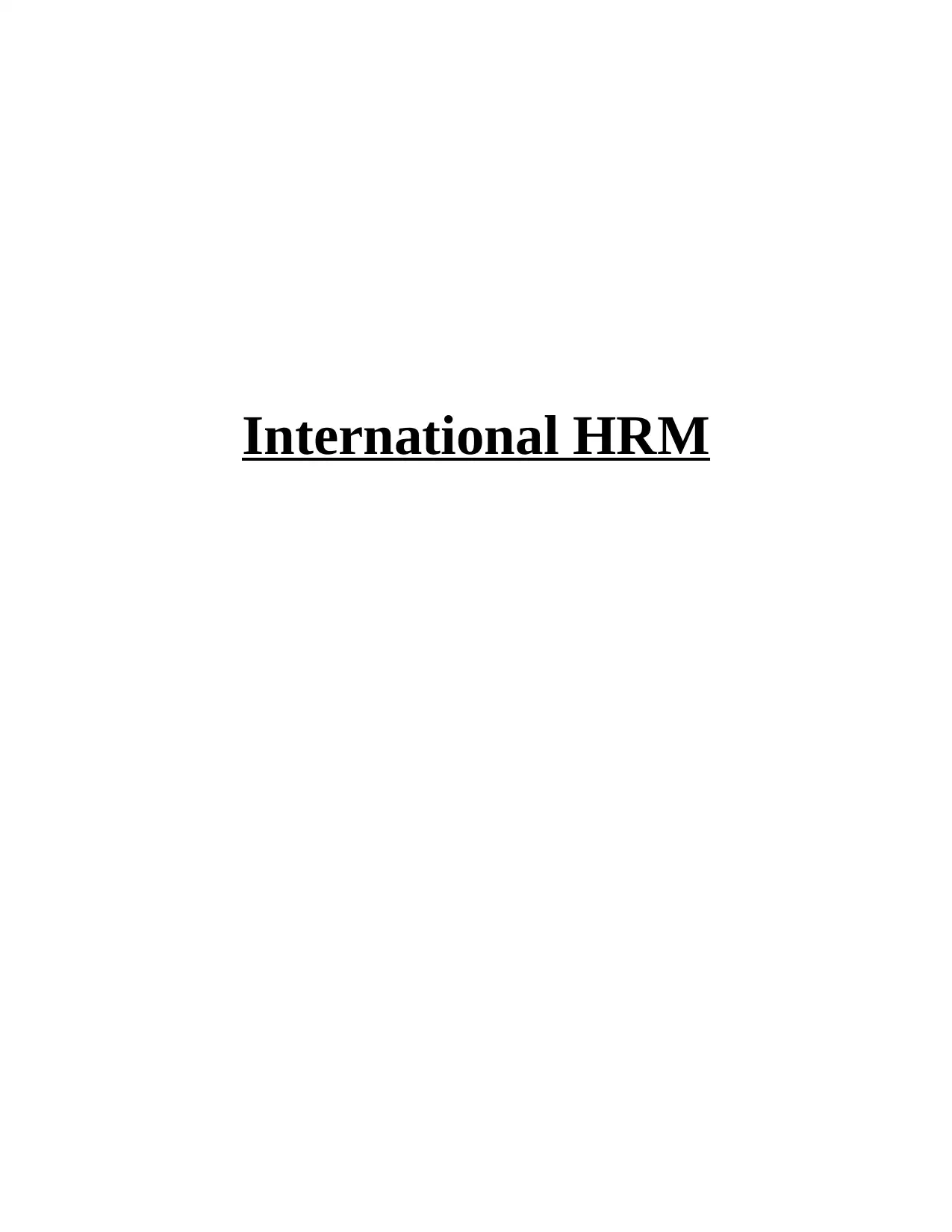
International HRM
Paraphrase This Document
Need a fresh take? Get an instant paraphrase of this document with our AI Paraphraser
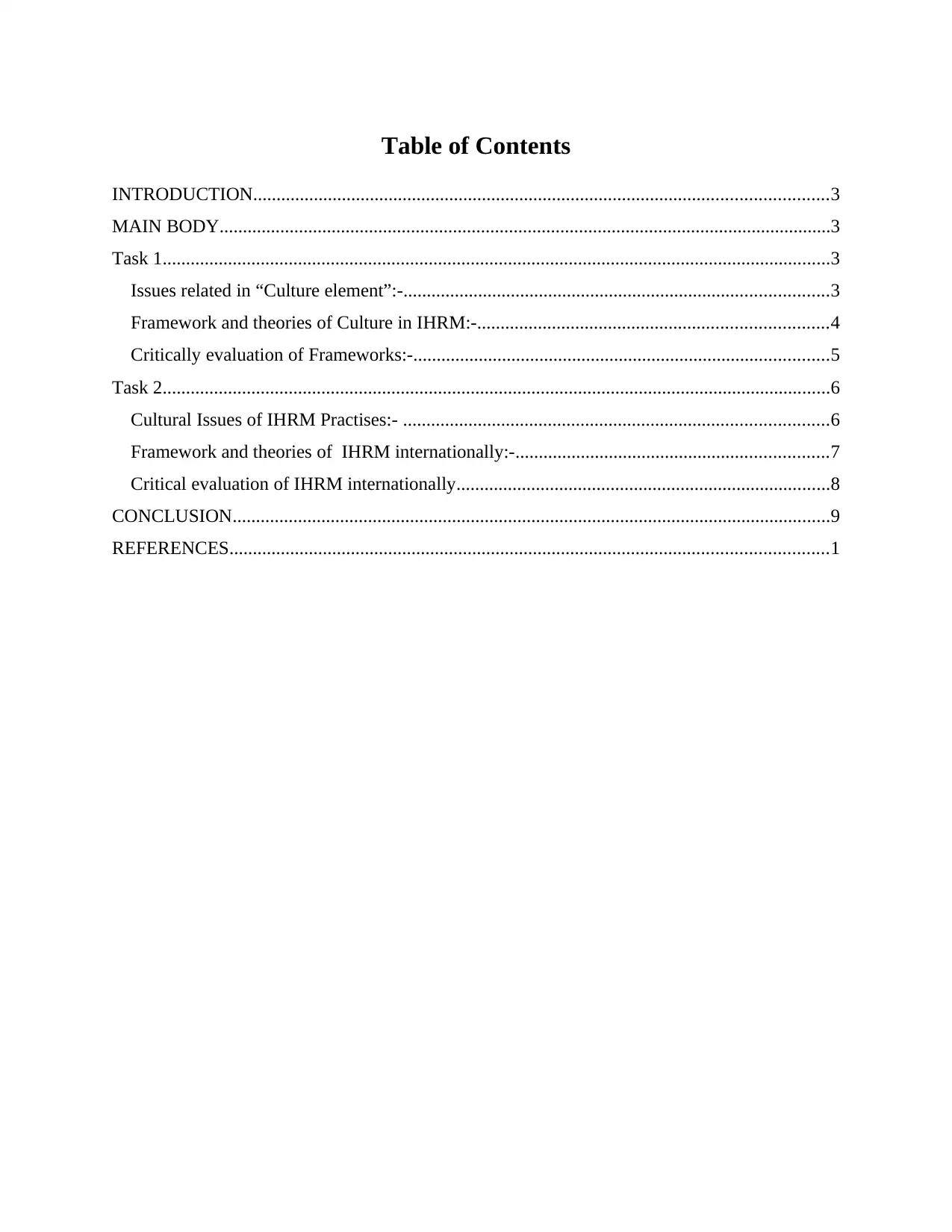
Table of Contents
INTRODUCTION...........................................................................................................................3
MAIN BODY...................................................................................................................................3
Task 1...............................................................................................................................................3
Issues related in “Culture element”:-...........................................................................................3
Framework and theories of Culture in IHRM:-...........................................................................4
Critically evaluation of Frameworks:-.........................................................................................5
Task 2...............................................................................................................................................6
Cultural Issues of IHRM Practises:- ...........................................................................................6
Framework and theories of IHRM internationally:-...................................................................7
Critical evaluation of IHRM internationally................................................................................8
CONCLUSION................................................................................................................................9
REFERENCES................................................................................................................................1
INTRODUCTION...........................................................................................................................3
MAIN BODY...................................................................................................................................3
Task 1...............................................................................................................................................3
Issues related in “Culture element”:-...........................................................................................3
Framework and theories of Culture in IHRM:-...........................................................................4
Critically evaluation of Frameworks:-.........................................................................................5
Task 2...............................................................................................................................................6
Cultural Issues of IHRM Practises:- ...........................................................................................6
Framework and theories of IHRM internationally:-...................................................................7
Critical evaluation of IHRM internationally................................................................................8
CONCLUSION................................................................................................................................9
REFERENCES................................................................................................................................1
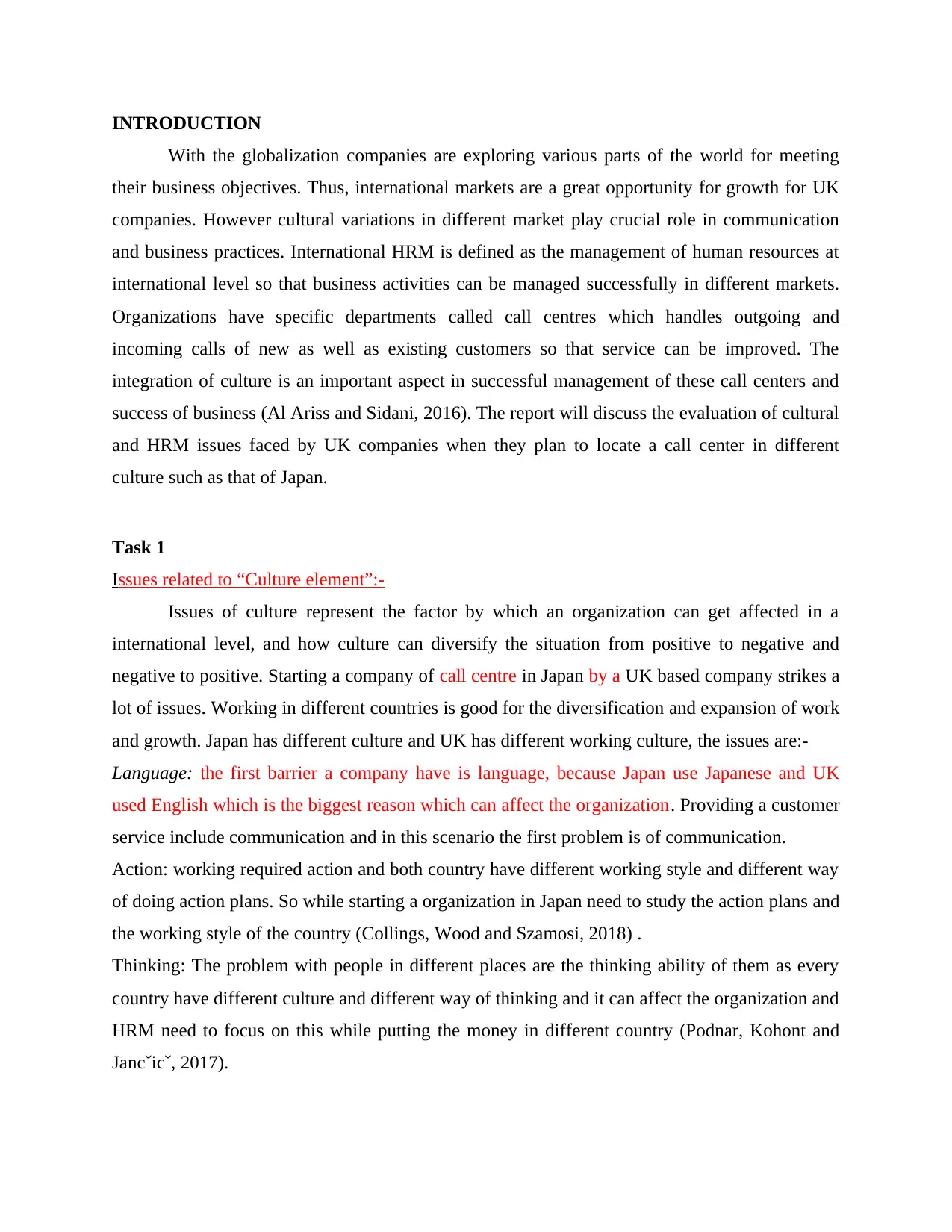
INTRODUCTION
With the globalization companies are exploring various parts of the world for meeting
their business objectives. Thus, international markets are a great opportunity for growth for UK
companies. However cultural variations in different market play crucial role in communication
and business practices. International HRM is defined as the management of human resources at
international level so that business activities can be managed successfully in different markets.
Organizations have specific departments called call centres which handles outgoing and
incoming calls of new as well as existing customers so that service can be improved. The
integration of culture is an important aspect in successful management of these call centers and
success of business (Al Ariss and Sidani, 2016). The report will discuss the evaluation of cultural
and HRM issues faced by UK companies when they plan to locate a call center in different
culture such as that of Japan.
Task 1
Issues related to “Culture element”:-
Issues of culture represent the factor by which an organization can get affected in a
international level, and how culture can diversify the situation from positive to negative and
negative to positive. Starting a company of call centre in Japan by a UK based company strikes a
lot of issues. Working in different countries is good for the diversification and expansion of work
and growth. Japan has different culture and UK has different working culture, the issues are:-
Language: the first barrier a company have is language, because Japan use Japanese and UK
used English which is the biggest reason which can affect the organization. Providing a customer
service include communication and in this scenario the first problem is of communication.
Action: working required action and both country have different working style and different way
of doing action plans. So while starting a organization in Japan need to study the action plans and
the working style of the country (Collings, Wood and Szamosi, 2018) .
Thinking: The problem with people in different places are the thinking ability of them as every
country have different culture and different way of thinking and it can affect the organization and
HRM need to focus on this while putting the money in different country (Podnar, Kohont and
Jancˇicˇ, 2017).
With the globalization companies are exploring various parts of the world for meeting
their business objectives. Thus, international markets are a great opportunity for growth for UK
companies. However cultural variations in different market play crucial role in communication
and business practices. International HRM is defined as the management of human resources at
international level so that business activities can be managed successfully in different markets.
Organizations have specific departments called call centres which handles outgoing and
incoming calls of new as well as existing customers so that service can be improved. The
integration of culture is an important aspect in successful management of these call centers and
success of business (Al Ariss and Sidani, 2016). The report will discuss the evaluation of cultural
and HRM issues faced by UK companies when they plan to locate a call center in different
culture such as that of Japan.
Task 1
Issues related to “Culture element”:-
Issues of culture represent the factor by which an organization can get affected in a
international level, and how culture can diversify the situation from positive to negative and
negative to positive. Starting a company of call centre in Japan by a UK based company strikes a
lot of issues. Working in different countries is good for the diversification and expansion of work
and growth. Japan has different culture and UK has different working culture, the issues are:-
Language: the first barrier a company have is language, because Japan use Japanese and UK
used English which is the biggest reason which can affect the organization. Providing a customer
service include communication and in this scenario the first problem is of communication.
Action: working required action and both country have different working style and different way
of doing action plans. So while starting a organization in Japan need to study the action plans and
the working style of the country (Collings, Wood and Szamosi, 2018) .
Thinking: The problem with people in different places are the thinking ability of them as every
country have different culture and different way of thinking and it can affect the organization and
HRM need to focus on this while putting the money in different country (Podnar, Kohont and
Jancˇicˇ, 2017).
⊘ This is a preview!⊘
Do you want full access?
Subscribe today to unlock all pages.

Trusted by 1+ million students worldwide
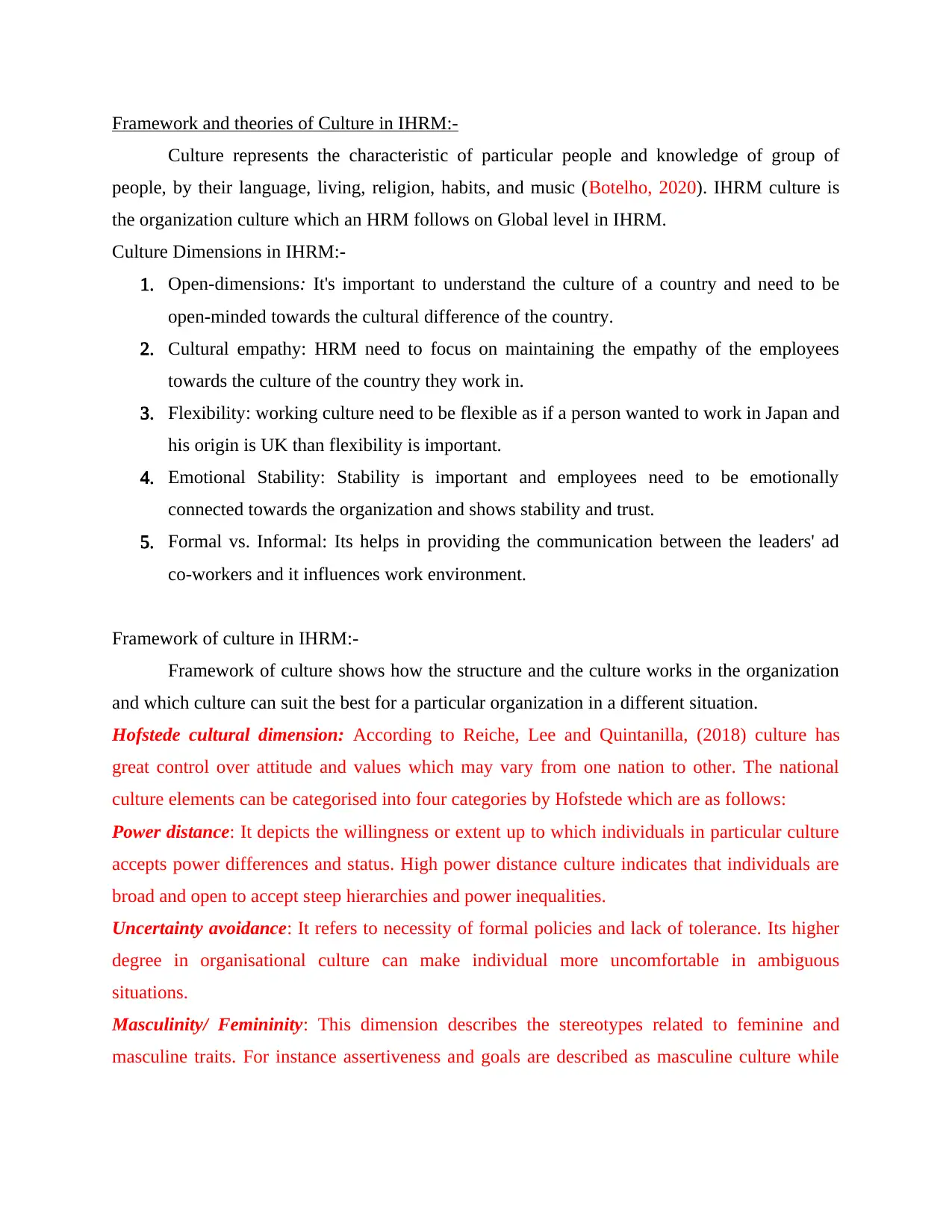
Framework and theories of Culture in IHRM:-
Culture represents the characteristic of particular people and knowledge of group of
people, by their language, living, religion, habits, and music (Botelho, 2020). IHRM culture is
the organization culture which an HRM follows on Global level in IHRM.
Culture Dimensions in IHRM:-
1. Open-dimensions: It's important to understand the culture of a country and need to be
open-minded towards the cultural difference of the country.
2. Cultural empathy: HRM need to focus on maintaining the empathy of the employees
towards the culture of the country they work in.
3. Flexibility: working culture need to be flexible as if a person wanted to work in Japan and
his origin is UK than flexibility is important.
4. Emotional Stability: Stability is important and employees need to be emotionally
connected towards the organization and shows stability and trust.
5. Formal vs. Informal: Its helps in providing the communication between the leaders' ad
co-workers and it influences work environment.
Framework of culture in IHRM:-
Framework of culture shows how the structure and the culture works in the organization
and which culture can suit the best for a particular organization in a different situation.
Hofstede cultural dimension: According to Reiche, Lee and Quintanilla, (2018) culture has
great control over attitude and values which may vary from one nation to other. The national
culture elements can be categorised into four categories by Hofstede which are as follows:
Power distance: It depicts the willingness or extent up to which individuals in particular culture
accepts power differences and status. High power distance culture indicates that individuals are
broad and open to accept steep hierarchies and power inequalities.
Uncertainty avoidance: It refers to necessity of formal policies and lack of tolerance. Its higher
degree in organisational culture can make individual more uncomfortable in ambiguous
situations.
Masculinity/ Femininity: This dimension describes the stereotypes related to feminine and
masculine traits. For instance assertiveness and goals are described as masculine culture while
Culture represents the characteristic of particular people and knowledge of group of
people, by their language, living, religion, habits, and music (Botelho, 2020). IHRM culture is
the organization culture which an HRM follows on Global level in IHRM.
Culture Dimensions in IHRM:-
1. Open-dimensions: It's important to understand the culture of a country and need to be
open-minded towards the cultural difference of the country.
2. Cultural empathy: HRM need to focus on maintaining the empathy of the employees
towards the culture of the country they work in.
3. Flexibility: working culture need to be flexible as if a person wanted to work in Japan and
his origin is UK than flexibility is important.
4. Emotional Stability: Stability is important and employees need to be emotionally
connected towards the organization and shows stability and trust.
5. Formal vs. Informal: Its helps in providing the communication between the leaders' ad
co-workers and it influences work environment.
Framework of culture in IHRM:-
Framework of culture shows how the structure and the culture works in the organization
and which culture can suit the best for a particular organization in a different situation.
Hofstede cultural dimension: According to Reiche, Lee and Quintanilla, (2018) culture has
great control over attitude and values which may vary from one nation to other. The national
culture elements can be categorised into four categories by Hofstede which are as follows:
Power distance: It depicts the willingness or extent up to which individuals in particular culture
accepts power differences and status. High power distance culture indicates that individuals are
broad and open to accept steep hierarchies and power inequalities.
Uncertainty avoidance: It refers to necessity of formal policies and lack of tolerance. Its higher
degree in organisational culture can make individual more uncomfortable in ambiguous
situations.
Masculinity/ Femininity: This dimension describes the stereotypes related to feminine and
masculine traits. For instance assertiveness and goals are described as masculine culture while
Paraphrase This Document
Need a fresh take? Get an instant paraphrase of this document with our AI Paraphraser
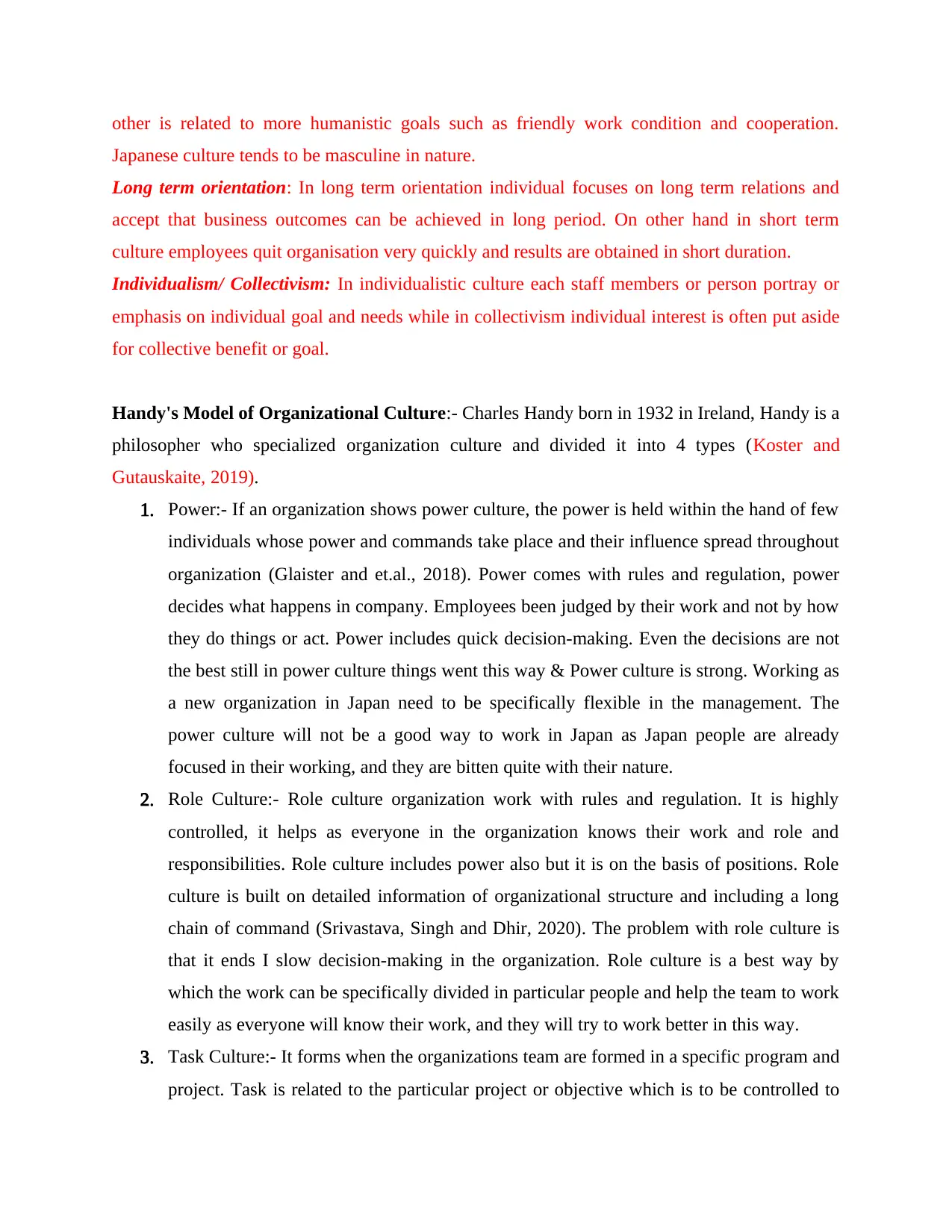
other is related to more humanistic goals such as friendly work condition and cooperation.
Japanese culture tends to be masculine in nature.
Long term orientation: In long term orientation individual focuses on long term relations and
accept that business outcomes can be achieved in long period. On other hand in short term
culture employees quit organisation very quickly and results are obtained in short duration.
Individualism/ Collectivism: In individualistic culture each staff members or person portray or
emphasis on individual goal and needs while in collectivism individual interest is often put aside
for collective benefit or goal.
Handy's Model of Organizational Culture:- Charles Handy born in 1932 in Ireland, Handy is a
philosopher who specialized organization culture and divided it into 4 types (Koster and
Gutauskaite, 2019).
1. Power:- If an organization shows power culture, the power is held within the hand of few
individuals whose power and commands take place and their influence spread throughout
organization (Glaister and et.al., 2018). Power comes with rules and regulation, power
decides what happens in company. Employees been judged by their work and not by how
they do things or act. Power includes quick decision-making. Even the decisions are not
the best still in power culture things went this way & Power culture is strong. Working as
a new organization in Japan need to be specifically flexible in the management. The
power culture will not be a good way to work in Japan as Japan people are already
focused in their working, and they are bitten quite with their nature.
2. Role Culture:- Role culture organization work with rules and regulation. It is highly
controlled, it helps as everyone in the organization knows their work and role and
responsibilities. Role culture includes power also but it is on the basis of positions. Role
culture is built on detailed information of organizational structure and including a long
chain of command (Srivastava, Singh and Dhir, 2020). The problem with role culture is
that it ends I slow decision-making in the organization. Role culture is a best way by
which the work can be specifically divided in particular people and help the team to work
easily as everyone will know their work, and they will try to work better in this way.
3. Task Culture:- It forms when the organizations team are formed in a specific program and
project. Task is related to the particular project or objective which is to be controlled to
Japanese culture tends to be masculine in nature.
Long term orientation: In long term orientation individual focuses on long term relations and
accept that business outcomes can be achieved in long period. On other hand in short term
culture employees quit organisation very quickly and results are obtained in short duration.
Individualism/ Collectivism: In individualistic culture each staff members or person portray or
emphasis on individual goal and needs while in collectivism individual interest is often put aside
for collective benefit or goal.
Handy's Model of Organizational Culture:- Charles Handy born in 1932 in Ireland, Handy is a
philosopher who specialized organization culture and divided it into 4 types (Koster and
Gutauskaite, 2019).
1. Power:- If an organization shows power culture, the power is held within the hand of few
individuals whose power and commands take place and their influence spread throughout
organization (Glaister and et.al., 2018). Power comes with rules and regulation, power
decides what happens in company. Employees been judged by their work and not by how
they do things or act. Power includes quick decision-making. Even the decisions are not
the best still in power culture things went this way & Power culture is strong. Working as
a new organization in Japan need to be specifically flexible in the management. The
power culture will not be a good way to work in Japan as Japan people are already
focused in their working, and they are bitten quite with their nature.
2. Role Culture:- Role culture organization work with rules and regulation. It is highly
controlled, it helps as everyone in the organization knows their work and role and
responsibilities. Role culture includes power also but it is on the basis of positions. Role
culture is built on detailed information of organizational structure and including a long
chain of command (Srivastava, Singh and Dhir, 2020). The problem with role culture is
that it ends I slow decision-making in the organization. Role culture is a best way by
which the work can be specifically divided in particular people and help the team to work
easily as everyone will know their work, and they will try to work better in this way.
3. Task Culture:- It forms when the organizations team are formed in a specific program and
project. Task is related to the particular project or objective which is to be controlled to
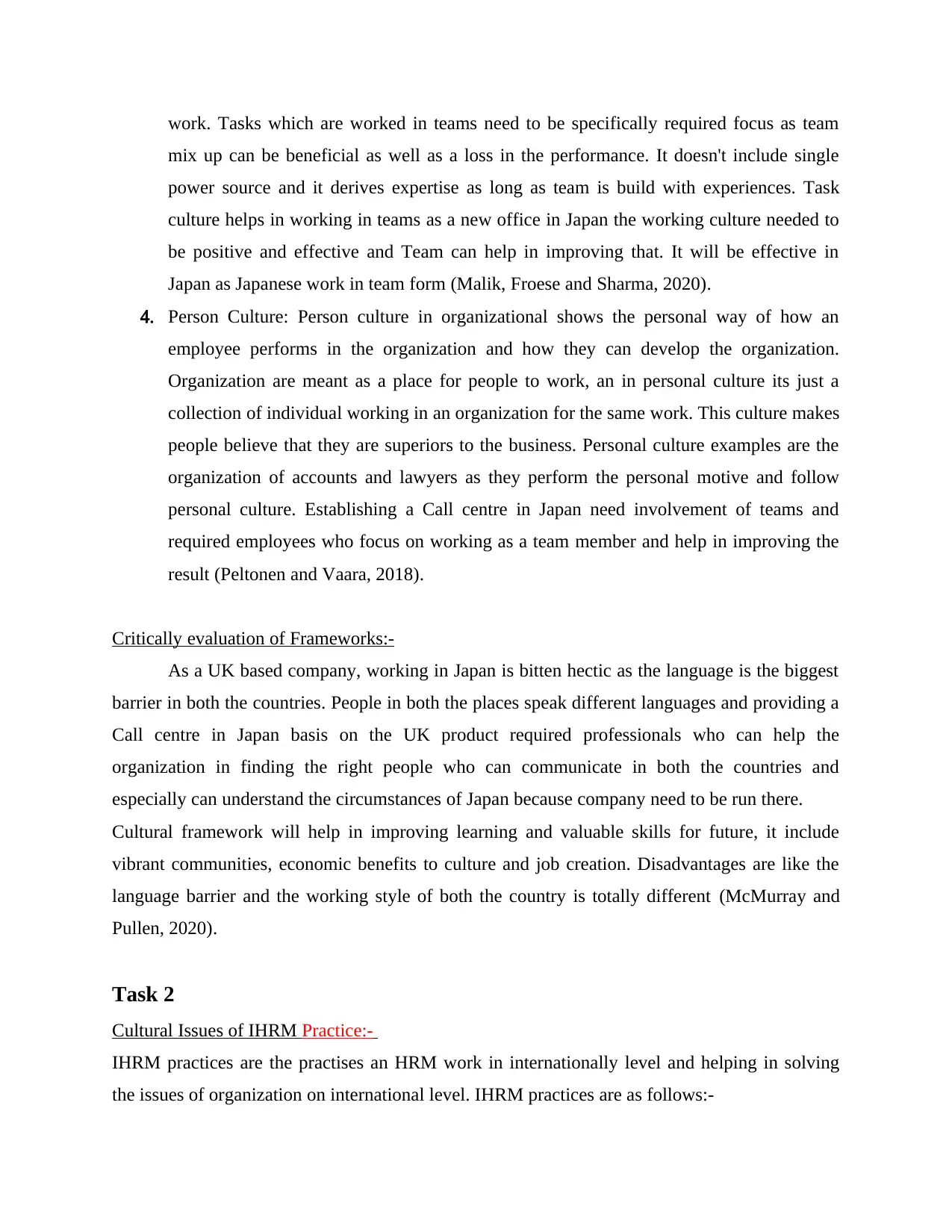
work. Tasks which are worked in teams need to be specifically required focus as team
mix up can be beneficial as well as a loss in the performance. It doesn't include single
power source and it derives expertise as long as team is build with experiences. Task
culture helps in working in teams as a new office in Japan the working culture needed to
be positive and effective and Team can help in improving that. It will be effective in
Japan as Japanese work in team form (Malik, Froese and Sharma, 2020).
4. Person Culture: Person culture in organizational shows the personal way of how an
employee performs in the organization and how they can develop the organization.
Organization are meant as a place for people to work, an in personal culture its just a
collection of individual working in an organization for the same work. This culture makes
people believe that they are superiors to the business. Personal culture examples are the
organization of accounts and lawyers as they perform the personal motive and follow
personal culture. Establishing a Call centre in Japan need involvement of teams and
required employees who focus on working as a team member and help in improving the
result (Peltonen and Vaara, 2018).
Critically evaluation of Frameworks:-
As a UK based company, working in Japan is bitten hectic as the language is the biggest
barrier in both the countries. People in both the places speak different languages and providing a
Call centre in Japan basis on the UK product required professionals who can help the
organization in finding the right people who can communicate in both the countries and
especially can understand the circumstances of Japan because company need to be run there.
Cultural framework will help in improving learning and valuable skills for future, it include
vibrant communities, economic benefits to culture and job creation. Disadvantages are like the
language barrier and the working style of both the country is totally different (McMurray and
Pullen, 2020).
Task 2
Cultural Issues of IHRM Practice:-
IHRM practices are the practises an HRM work in internationally level and helping in solving
the issues of organization on international level. IHRM practices are as follows:-
mix up can be beneficial as well as a loss in the performance. It doesn't include single
power source and it derives expertise as long as team is build with experiences. Task
culture helps in working in teams as a new office in Japan the working culture needed to
be positive and effective and Team can help in improving that. It will be effective in
Japan as Japanese work in team form (Malik, Froese and Sharma, 2020).
4. Person Culture: Person culture in organizational shows the personal way of how an
employee performs in the organization and how they can develop the organization.
Organization are meant as a place for people to work, an in personal culture its just a
collection of individual working in an organization for the same work. This culture makes
people believe that they are superiors to the business. Personal culture examples are the
organization of accounts and lawyers as they perform the personal motive and follow
personal culture. Establishing a Call centre in Japan need involvement of teams and
required employees who focus on working as a team member and help in improving the
result (Peltonen and Vaara, 2018).
Critically evaluation of Frameworks:-
As a UK based company, working in Japan is bitten hectic as the language is the biggest
barrier in both the countries. People in both the places speak different languages and providing a
Call centre in Japan basis on the UK product required professionals who can help the
organization in finding the right people who can communicate in both the countries and
especially can understand the circumstances of Japan because company need to be run there.
Cultural framework will help in improving learning and valuable skills for future, it include
vibrant communities, economic benefits to culture and job creation. Disadvantages are like the
language barrier and the working style of both the country is totally different (McMurray and
Pullen, 2020).
Task 2
Cultural Issues of IHRM Practice:-
IHRM practices are the practises an HRM work in internationally level and helping in solving
the issues of organization on international level. IHRM practices are as follows:-
⊘ This is a preview!⊘
Do you want full access?
Subscribe today to unlock all pages.

Trusted by 1+ million students worldwide
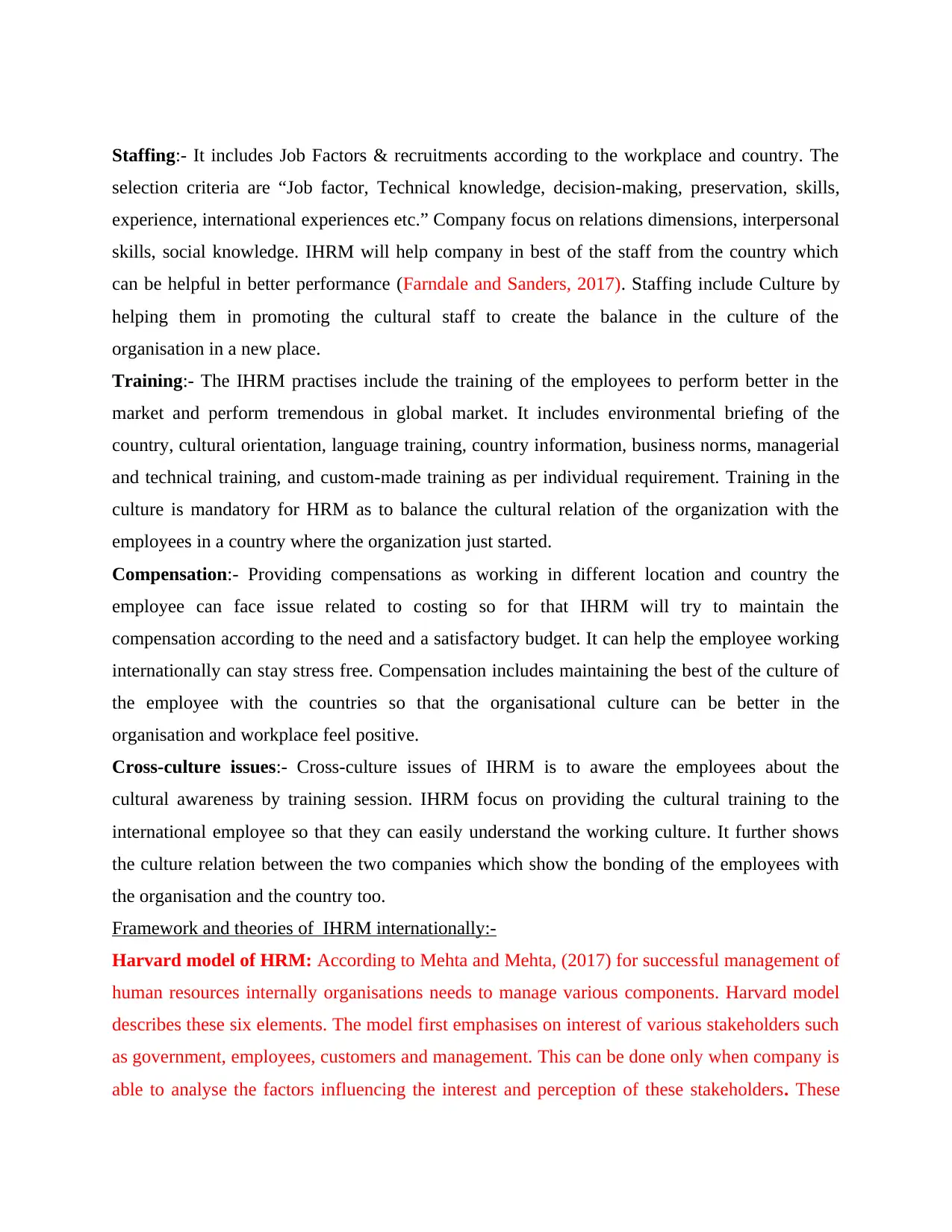
Staffing:- It includes Job Factors & recruitments according to the workplace and country. The
selection criteria are “Job factor, Technical knowledge, decision-making, preservation, skills,
experience, international experiences etc.” Company focus on relations dimensions, interpersonal
skills, social knowledge. IHRM will help company in best of the staff from the country which
can be helpful in better performance (Farndale and Sanders, 2017). Staffing include Culture by
helping them in promoting the cultural staff to create the balance in the culture of the
organisation in a new place.
Training:- The IHRM practises include the training of the employees to perform better in the
market and perform tremendous in global market. It includes environmental briefing of the
country, cultural orientation, language training, country information, business norms, managerial
and technical training, and custom-made training as per individual requirement. Training in the
culture is mandatory for HRM as to balance the cultural relation of the organization with the
employees in a country where the organization just started.
Compensation:- Providing compensations as working in different location and country the
employee can face issue related to costing so for that IHRM will try to maintain the
compensation according to the need and a satisfactory budget. It can help the employee working
internationally can stay stress free. Compensation includes maintaining the best of the culture of
the employee with the countries so that the organisational culture can be better in the
organisation and workplace feel positive.
Cross-culture issues:- Cross-culture issues of IHRM is to aware the employees about the
cultural awareness by training session. IHRM focus on providing the cultural training to the
international employee so that they can easily understand the working culture. It further shows
the culture relation between the two companies which show the bonding of the employees with
the organisation and the country too.
Framework and theories of IHRM internationally:-
Harvard model of HRM: According to Mehta and Mehta, (2017) for successful management of
human resources internally organisations needs to manage various components. Harvard model
describes these six elements. The model first emphasises on interest of various stakeholders such
as government, employees, customers and management. This can be done only when company is
able to analyse the factors influencing the interest and perception of these stakeholders. These
selection criteria are “Job factor, Technical knowledge, decision-making, preservation, skills,
experience, international experiences etc.” Company focus on relations dimensions, interpersonal
skills, social knowledge. IHRM will help company in best of the staff from the country which
can be helpful in better performance (Farndale and Sanders, 2017). Staffing include Culture by
helping them in promoting the cultural staff to create the balance in the culture of the
organisation in a new place.
Training:- The IHRM practises include the training of the employees to perform better in the
market and perform tremendous in global market. It includes environmental briefing of the
country, cultural orientation, language training, country information, business norms, managerial
and technical training, and custom-made training as per individual requirement. Training in the
culture is mandatory for HRM as to balance the cultural relation of the organization with the
employees in a country where the organization just started.
Compensation:- Providing compensations as working in different location and country the
employee can face issue related to costing so for that IHRM will try to maintain the
compensation according to the need and a satisfactory budget. It can help the employee working
internationally can stay stress free. Compensation includes maintaining the best of the culture of
the employee with the countries so that the organisational culture can be better in the
organisation and workplace feel positive.
Cross-culture issues:- Cross-culture issues of IHRM is to aware the employees about the
cultural awareness by training session. IHRM focus on providing the cultural training to the
international employee so that they can easily understand the working culture. It further shows
the culture relation between the two companies which show the bonding of the employees with
the organisation and the country too.
Framework and theories of IHRM internationally:-
Harvard model of HRM: According to Mehta and Mehta, (2017) for successful management of
human resources internally organisations needs to manage various components. Harvard model
describes these six elements. The model first emphasises on interest of various stakeholders such
as government, employees, customers and management. This can be done only when company is
able to analyse the factors influencing the interest and perception of these stakeholders. These
Paraphrase This Document
Need a fresh take? Get an instant paraphrase of this document with our AI Paraphraser
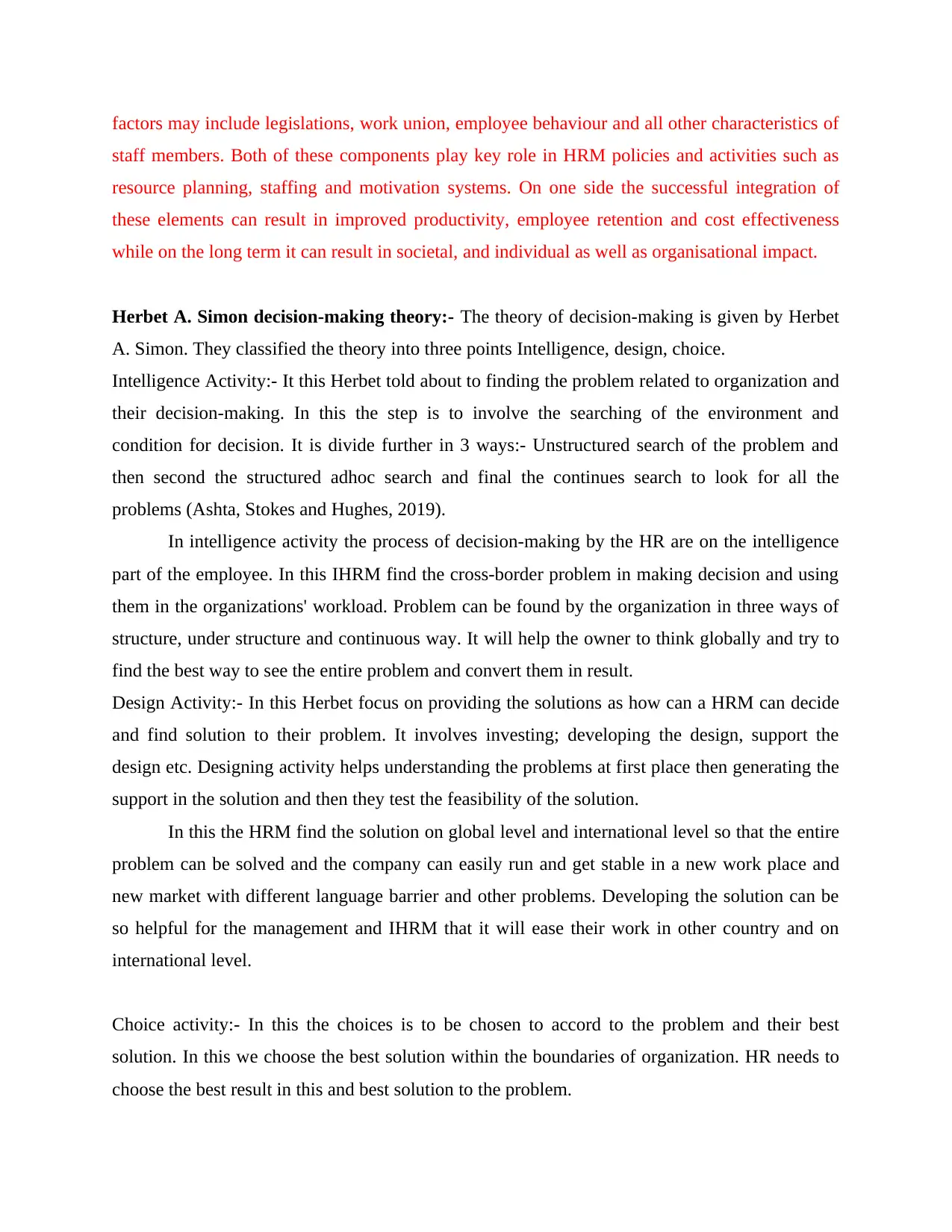
factors may include legislations, work union, employee behaviour and all other characteristics of
staff members. Both of these components play key role in HRM policies and activities such as
resource planning, staffing and motivation systems. On one side the successful integration of
these elements can result in improved productivity, employee retention and cost effectiveness
while on the long term it can result in societal, and individual as well as organisational impact.
Herbet A. Simon decision-making theory:- The theory of decision-making is given by Herbet
A. Simon. They classified the theory into three points Intelligence, design, choice.
Intelligence Activity:- It this Herbet told about to finding the problem related to organization and
their decision-making. In this the step is to involve the searching of the environment and
condition for decision. It is divide further in 3 ways:- Unstructured search of the problem and
then second the structured adhoc search and final the continues search to look for all the
problems (Ashta, Stokes and Hughes, 2019).
In intelligence activity the process of decision-making by the HR are on the intelligence
part of the employee. In this IHRM find the cross-border problem in making decision and using
them in the organizations' workload. Problem can be found by the organization in three ways of
structure, under structure and continuous way. It will help the owner to think globally and try to
find the best way to see the entire problem and convert them in result.
Design Activity:- In this Herbet focus on providing the solutions as how can a HRM can decide
and find solution to their problem. It involves investing; developing the design, support the
design etc. Designing activity helps understanding the problems at first place then generating the
support in the solution and then they test the feasibility of the solution.
In this the HRM find the solution on global level and international level so that the entire
problem can be solved and the company can easily run and get stable in a new work place and
new market with different language barrier and other problems. Developing the solution can be
so helpful for the management and IHRM that it will ease their work in other country and on
international level.
Choice activity:- In this the choices is to be chosen to accord to the problem and their best
solution. In this we choose the best solution within the boundaries of organization. HR needs to
choose the best result in this and best solution to the problem.
staff members. Both of these components play key role in HRM policies and activities such as
resource planning, staffing and motivation systems. On one side the successful integration of
these elements can result in improved productivity, employee retention and cost effectiveness
while on the long term it can result in societal, and individual as well as organisational impact.
Herbet A. Simon decision-making theory:- The theory of decision-making is given by Herbet
A. Simon. They classified the theory into three points Intelligence, design, choice.
Intelligence Activity:- It this Herbet told about to finding the problem related to organization and
their decision-making. In this the step is to involve the searching of the environment and
condition for decision. It is divide further in 3 ways:- Unstructured search of the problem and
then second the structured adhoc search and final the continues search to look for all the
problems (Ashta, Stokes and Hughes, 2019).
In intelligence activity the process of decision-making by the HR are on the intelligence
part of the employee. In this IHRM find the cross-border problem in making decision and using
them in the organizations' workload. Problem can be found by the organization in three ways of
structure, under structure and continuous way. It will help the owner to think globally and try to
find the best way to see the entire problem and convert them in result.
Design Activity:- In this Herbet focus on providing the solutions as how can a HRM can decide
and find solution to their problem. It involves investing; developing the design, support the
design etc. Designing activity helps understanding the problems at first place then generating the
support in the solution and then they test the feasibility of the solution.
In this the HRM find the solution on global level and international level so that the entire
problem can be solved and the company can easily run and get stable in a new work place and
new market with different language barrier and other problems. Developing the solution can be
so helpful for the management and IHRM that it will ease their work in other country and on
international level.
Choice activity:- In this the choices is to be chosen to accord to the problem and their best
solution. In this we choose the best solution within the boundaries of organization. HR needs to
choose the best result in this and best solution to the problem.
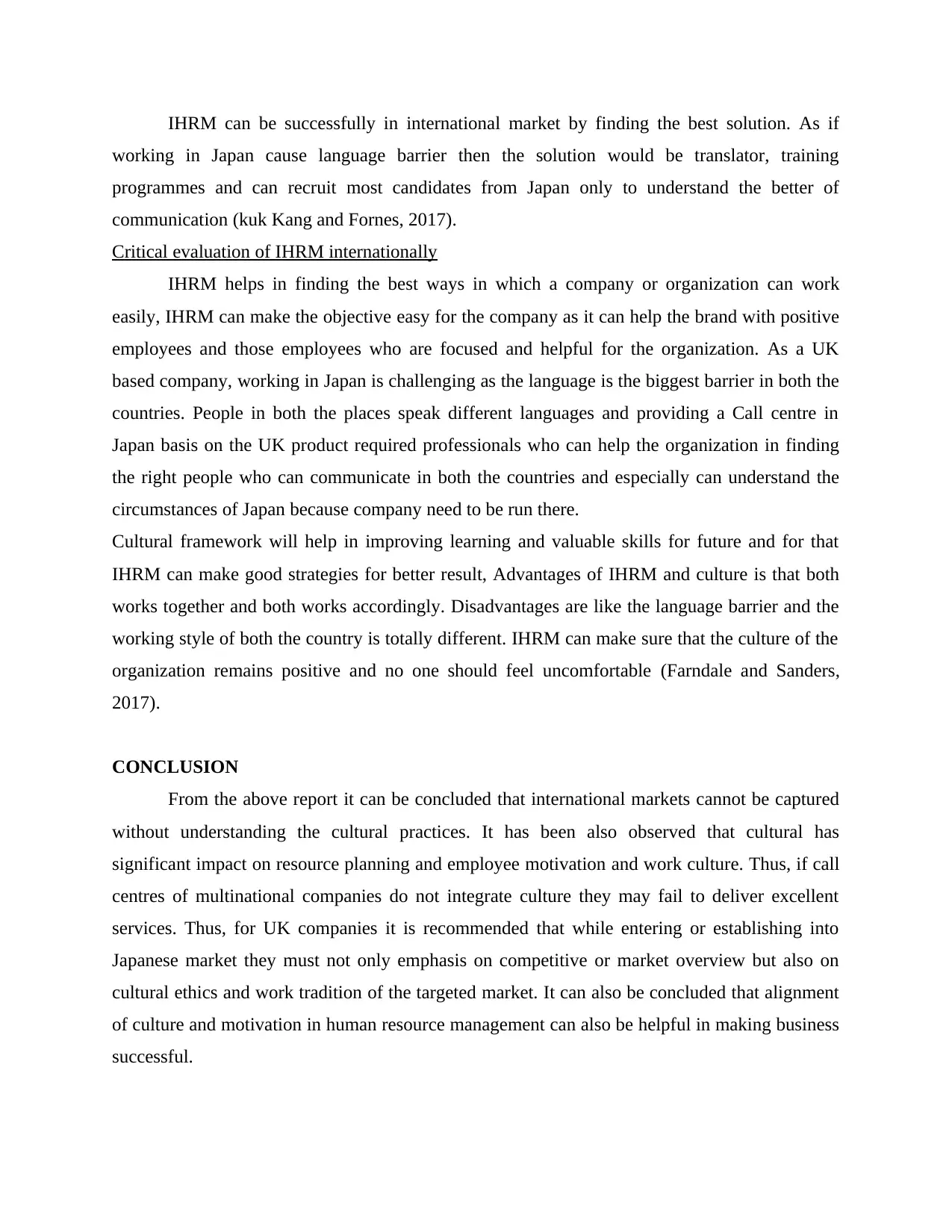
IHRM can be successfully in international market by finding the best solution. As if
working in Japan cause language barrier then the solution would be translator, training
programmes and can recruit most candidates from Japan only to understand the better of
communication (kuk Kang and Fornes, 2017).
Critical evaluation of IHRM internationally
IHRM helps in finding the best ways in which a company or organization can work
easily, IHRM can make the objective easy for the company as it can help the brand with positive
employees and those employees who are focused and helpful for the organization. As a UK
based company, working in Japan is challenging as the language is the biggest barrier in both the
countries. People in both the places speak different languages and providing a Call centre in
Japan basis on the UK product required professionals who can help the organization in finding
the right people who can communicate in both the countries and especially can understand the
circumstances of Japan because company need to be run there.
Cultural framework will help in improving learning and valuable skills for future and for that
IHRM can make good strategies for better result, Advantages of IHRM and culture is that both
works together and both works accordingly. Disadvantages are like the language barrier and the
working style of both the country is totally different. IHRM can make sure that the culture of the
organization remains positive and no one should feel uncomfortable (Farndale and Sanders,
2017).
CONCLUSION
From the above report it can be concluded that international markets cannot be captured
without understanding the cultural practices. It has been also observed that cultural has
significant impact on resource planning and employee motivation and work culture. Thus, if call
centres of multinational companies do not integrate culture they may fail to deliver excellent
services. Thus, for UK companies it is recommended that while entering or establishing into
Japanese market they must not only emphasis on competitive or market overview but also on
cultural ethics and work tradition of the targeted market. It can also be concluded that alignment
of culture and motivation in human resource management can also be helpful in making business
successful.
working in Japan cause language barrier then the solution would be translator, training
programmes and can recruit most candidates from Japan only to understand the better of
communication (kuk Kang and Fornes, 2017).
Critical evaluation of IHRM internationally
IHRM helps in finding the best ways in which a company or organization can work
easily, IHRM can make the objective easy for the company as it can help the brand with positive
employees and those employees who are focused and helpful for the organization. As a UK
based company, working in Japan is challenging as the language is the biggest barrier in both the
countries. People in both the places speak different languages and providing a Call centre in
Japan basis on the UK product required professionals who can help the organization in finding
the right people who can communicate in both the countries and especially can understand the
circumstances of Japan because company need to be run there.
Cultural framework will help in improving learning and valuable skills for future and for that
IHRM can make good strategies for better result, Advantages of IHRM and culture is that both
works together and both works accordingly. Disadvantages are like the language barrier and the
working style of both the country is totally different. IHRM can make sure that the culture of the
organization remains positive and no one should feel uncomfortable (Farndale and Sanders,
2017).
CONCLUSION
From the above report it can be concluded that international markets cannot be captured
without understanding the cultural practices. It has been also observed that cultural has
significant impact on resource planning and employee motivation and work culture. Thus, if call
centres of multinational companies do not integrate culture they may fail to deliver excellent
services. Thus, for UK companies it is recommended that while entering or establishing into
Japanese market they must not only emphasis on competitive or market overview but also on
cultural ethics and work tradition of the targeted market. It can also be concluded that alignment
of culture and motivation in human resource management can also be helpful in making business
successful.
⊘ This is a preview!⊘
Do you want full access?
Subscribe today to unlock all pages.

Trusted by 1+ million students worldwide
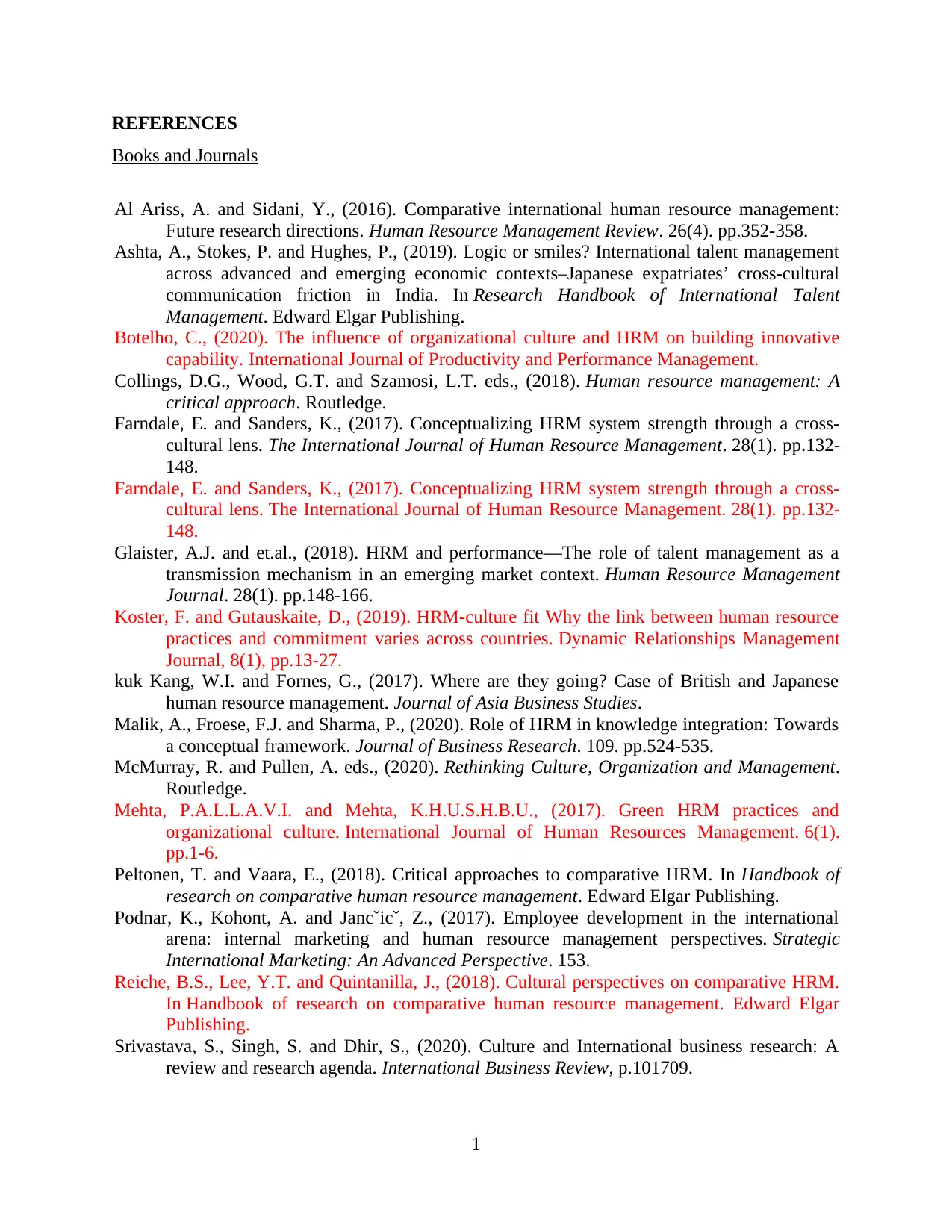
REFERENCES
Books and Journals
Al Ariss, A. and Sidani, Y., (2016). Comparative international human resource management:
Future research directions. Human Resource Management Review. 26(4). pp.352-358.
Ashta, A., Stokes, P. and Hughes, P., (2019). Logic or smiles? International talent management
across advanced and emerging economic contexts–Japanese expatriates’ cross-cultural
communication friction in India. In Research Handbook of International Talent
Management. Edward Elgar Publishing.
Botelho, C., (2020). The influence of organizational culture and HRM on building innovative
capability. International Journal of Productivity and Performance Management.
Collings, D.G., Wood, G.T. and Szamosi, L.T. eds., (2018). Human resource management: A
critical approach. Routledge.
Farndale, E. and Sanders, K., (2017). Conceptualizing HRM system strength through a cross-
cultural lens. The International Journal of Human Resource Management. 28(1). pp.132-
148.
Farndale, E. and Sanders, K., (2017). Conceptualizing HRM system strength through a cross-
cultural lens. The International Journal of Human Resource Management. 28(1). pp.132-
148.
Glaister, A.J. and et.al., (2018). HRM and performance—The role of talent management as a
transmission mechanism in an emerging market context. Human Resource Management
Journal. 28(1). pp.148-166.
Koster, F. and Gutauskaite, D., (2019). HRM-culture fit Why the link between human resource
practices and commitment varies across countries. Dynamic Relationships Management
Journal, 8(1), pp.13-27.
kuk Kang, W.I. and Fornes, G., (2017). Where are they going? Case of British and Japanese
human resource management. Journal of Asia Business Studies.
Malik, A., Froese, F.J. and Sharma, P., (2020). Role of HRM in knowledge integration: Towards
a conceptual framework. Journal of Business Research. 109. pp.524-535.
McMurray, R. and Pullen, A. eds., (2020). Rethinking Culture, Organization and Management.
Routledge.
Mehta, P.A.L.L.A.V.I. and Mehta, K.H.U.S.H.B.U., (2017). Green HRM practices and
organizational culture. International Journal of Human Resources Management. 6(1).
pp.1-6.
Peltonen, T. and Vaara, E., (2018). Critical approaches to comparative HRM. In Handbook of
research on comparative human resource management. Edward Elgar Publishing.
Podnar, K., Kohont, A. and Jancˇicˇ, Z., (2017). Employee development in the international
arena: internal marketing and human resource management perspectives. Strategic
International Marketing: An Advanced Perspective. 153.
Reiche, B.S., Lee, Y.T. and Quintanilla, J., (2018). Cultural perspectives on comparative HRM.
In Handbook of research on comparative human resource management. Edward Elgar
Publishing.
Srivastava, S., Singh, S. and Dhir, S., (2020). Culture and International business research: A
review and research agenda. International Business Review, p.101709.
1
Books and Journals
Al Ariss, A. and Sidani, Y., (2016). Comparative international human resource management:
Future research directions. Human Resource Management Review. 26(4). pp.352-358.
Ashta, A., Stokes, P. and Hughes, P., (2019). Logic or smiles? International talent management
across advanced and emerging economic contexts–Japanese expatriates’ cross-cultural
communication friction in India. In Research Handbook of International Talent
Management. Edward Elgar Publishing.
Botelho, C., (2020). The influence of organizational culture and HRM on building innovative
capability. International Journal of Productivity and Performance Management.
Collings, D.G., Wood, G.T. and Szamosi, L.T. eds., (2018). Human resource management: A
critical approach. Routledge.
Farndale, E. and Sanders, K., (2017). Conceptualizing HRM system strength through a cross-
cultural lens. The International Journal of Human Resource Management. 28(1). pp.132-
148.
Farndale, E. and Sanders, K., (2017). Conceptualizing HRM system strength through a cross-
cultural lens. The International Journal of Human Resource Management. 28(1). pp.132-
148.
Glaister, A.J. and et.al., (2018). HRM and performance—The role of talent management as a
transmission mechanism in an emerging market context. Human Resource Management
Journal. 28(1). pp.148-166.
Koster, F. and Gutauskaite, D., (2019). HRM-culture fit Why the link between human resource
practices and commitment varies across countries. Dynamic Relationships Management
Journal, 8(1), pp.13-27.
kuk Kang, W.I. and Fornes, G., (2017). Where are they going? Case of British and Japanese
human resource management. Journal of Asia Business Studies.
Malik, A., Froese, F.J. and Sharma, P., (2020). Role of HRM in knowledge integration: Towards
a conceptual framework. Journal of Business Research. 109. pp.524-535.
McMurray, R. and Pullen, A. eds., (2020). Rethinking Culture, Organization and Management.
Routledge.
Mehta, P.A.L.L.A.V.I. and Mehta, K.H.U.S.H.B.U., (2017). Green HRM practices and
organizational culture. International Journal of Human Resources Management. 6(1).
pp.1-6.
Peltonen, T. and Vaara, E., (2018). Critical approaches to comparative HRM. In Handbook of
research on comparative human resource management. Edward Elgar Publishing.
Podnar, K., Kohont, A. and Jancˇicˇ, Z., (2017). Employee development in the international
arena: internal marketing and human resource management perspectives. Strategic
International Marketing: An Advanced Perspective. 153.
Reiche, B.S., Lee, Y.T. and Quintanilla, J., (2018). Cultural perspectives on comparative HRM.
In Handbook of research on comparative human resource management. Edward Elgar
Publishing.
Srivastava, S., Singh, S. and Dhir, S., (2020). Culture and International business research: A
review and research agenda. International Business Review, p.101709.
1
1 out of 10
Related Documents
Your All-in-One AI-Powered Toolkit for Academic Success.
+13062052269
info@desklib.com
Available 24*7 on WhatsApp / Email
![[object Object]](/_next/static/media/star-bottom.7253800d.svg)
Unlock your academic potential
Copyright © 2020–2025 A2Z Services. All Rights Reserved. Developed and managed by ZUCOL.





